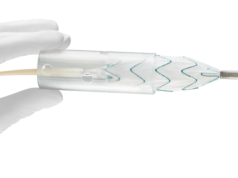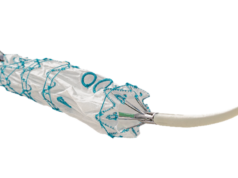
Terumo Aortic has announced the successful implantation of the company’s first custom-made thoracoabdominal hybrid device to treat thoracoabdominal aortic disease.
The world’s first thoracoabdominal repair procedure using a hybrid open stent graft was carried out by Sebastian Debus and supported by Sabine Wipper at University Heart Centre Hamburg (Hamburg, Germany). This procedure represents a key stage in the development of a device for the treatment of patients with thoracoabdominal aortic disease using minimally invasive surgical techniques.
Utilising technology from the company’s existing hybrid portfolio, the custom-made thoracoabdominal hybrid device incorporates a combination of Terumo Aortic’s Gelweave woven surgical and unique stent graft technology to address the patient’s specific anatomy.
Debus, chairman of the Department of Vascular Medicine, University Heart Centre Hamburg, commented: “This unique hybrid graft was designed in collaboration with Terumo Aortic to reduce the risk of complications associated with thoracotomy and extracorporeal circulation. The device consists of a proximal stent graft for transabdominal retrograde delivery to the descending aorta combined with a distal six-branched abdominal device for open abdominal aortic repair. The preliminary end-to-side anastomosed branch to the iliac artery allows continuous retrograde flow to the distal aorta following proximal stent graft deployment, and visceral vessels are subsequently anastomosed. This is the ‘first-in-human’ device implanted; it was easy to implant and the procedure was uneventful and straightforward. The patient showed ‘fast track’ recovery and postoperative course was without complications.”
Mark Miles, chief commercial officer at Terumo Aortic commented: “This milestone demonstrates our commitment to developing personalised solutions as part of our comprehensive surgical, endovascular and hybrid portfolio. Pushing forward with this type of innovation enables clinicians to treat a broader range of patients with anatomies that are not suitable for off-the-shelf products.”













